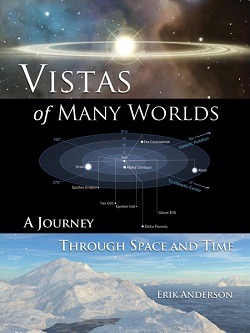Centauri Dreams
Imagining and Planning Interstellar Exploration
Images of Exoplanetary Journeys
Stretch out your time horizons and interstellar travel gets a bit easier. If 4.3 light years seems too immense a distance to reach Alpha Centauri, we can wait about 28,000 years, when the distance between us will have closed to 3.2 light years. As it turns out, Alpha Centauri is moving in a galactic orbit far different from the Sun’s. As we weave through the Milky Way in coming millennia, we’re in the midst of a close pass from a stellar system that will never be this close again. A few million years ago Alpha Centauri would not have been visible to the naked eye.
The great galactic pinball machine is in constant motion. Epsilon Indi, a slightly orange star about an eighth as luminous as the Sun and orbited by a pair of brown dwarfs, is currently 11.8 light years out, but it’s moving 90 kilometers per second relative to the Sun. In about 17,000 years, it will close to 10.6 light years before beginning to recede. Project Ozma target Tau Ceti, now 11.9 light years from our system, has a highly eccentric galactic orbit that, on its current inbound leg, will take it to within the same 10.6 light years if we can wait the necessary 43,000 years.
And here’s an interesting one I almost forgot to list, though its close pass may be the most intriguing of all. Gliese 710 is currently 64 light years away in the constellation Serpens. We have to wait a bit on this one, but the orange star, now at magnitude 9.7, will in 1.4 million years move within 50,000 AU of the Sun. That puts it close enough that it should interact with the Oort Cloud, perhaps perturbing comets there or sending comets from its own cometary cloud into our system. In any case, what a close-in target for future interstellar explorers!
I’m pulling all this from Erik Anderson’s new book Vistas of Many Worlds, whose subtitle — ‘A Journey Through Space and Time’ — is a bit deceptive, for the book actually contains four journeys. The first takes us on a tour of ten stars within 20 light years of the Sun, with full-page artwork on every other page and finder charts that diagram the stars in each illustration. The second tour moves through time and traces the stars of an evolving Earth through text and images. Itinerary three is a montage of scenes from known exoplanets, while the fourth tour takes us through a sequence of young Earth-like worlds as they develop.
Anderson’s text is absorbing — he’s a good writer with a knack for hitting the right note — but the artwork steals the show on many of these pages, for he’s been meticulous at recreating the sky as it would appear from other star systems. It becomes easy to track the Sun against the background of alien constellations. Thus a spectacular view of the pulsar planet PSR B1257+12 C shows our Sun lost among the brighter stars Canopus and Spica, with Rigel and Betelgeuse also prominent. The gorgeous sky above an icy ocean on a planet circling Delta Pavonis shows the Sun between Alpha Centauri and Eta Cassiopeiae. Stellar motion over time and the perspectives thus created from worlds much like our own are a major theme of this book.
From Epsilon Eridani, as seen in the image below, the Sun is a bright orb seen through the protoplanetary disk at about the 4 o’clock position below the bright central star.
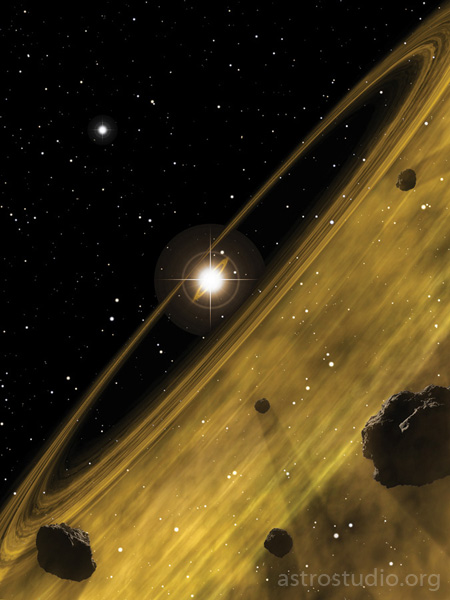
Image: The nearby orange dwarf star Epsilon Eridani reveals its circumstellar debris disks in this close-up perspective. Epsilon Eridani is only several hundred million years old and perhaps resembles the state of our own solar system during its early, formative years. Credit: Erik Anderson.
Vistas of Many Worlds assumes a basic background in astronomical concepts, but I think even younger readers will be caught up in the wonder of imagined scenes around planets we’re now discovering, which is why I’m buying a copy for my star-crazed grandson for Christmas. He’ll enjoy the movement through time as well as space. In one memorable scene, Anderson depicts a flock of ancient birds flying through a mountain pass 4.8 million years ago. At that time, the star Theta Columbae, today 720 light years away, was just seven light years out, outshining Venus and dominating the sunset skies of Anderson’s imagined landscape.
And what mysteries does the future hold? The end of the interglacial period is depicted in a scene Anderson sets 50,000 years from now, showing a futuristic observation station on the west coast of an ice-choked Canada. The frigid landscape and starfield above set the author speculating on how our descendants will see their options:
Will the inhabitants of a re-glaciating Earth seek refuge elsewhere? Alpha Centauri, our nearest celestial neighbor, has in all this time migrated out of the southern skies to the celestial equator, where it can be sighted from locations throughout the entire globe. It seems to beckon humanity to the stars.
And there, tagged by the star-finder chart and brightly shining on the facing image, is the Alpha Centauri system, now moving inexorably farther from our Sun but still a major marker in the night sky. Planet hunter Greg Laughlin has often commented on how satisfying it is that we have this intriguing stellar duo with accompanying red dwarf so relatively near to us as we begin the great exoplanet detection effort. We’re beginning to answer the question of planets around Alpha Centauri, though much work lies ahead. Perhaps some of that work will be accomplished by scientists who, in their younger years, were energized by the text and images of books like this one.

Tracking Changes in Titan’s Atmosphere
Even as New Horizons continues to push toward Pluto, now just past the halfway point between the orbits of Uranus and Neptune, we’re continuing to get excellent data from the much closer Cassini spacecraft around Saturn. Cassini’s composite infrared spectrometer (CIRS) is probing the circulation and chemistry of Titan’s atmosphere, tracking how gases like benzene and hydrogen cyanide are distributed and affected by changes in temperature and circulation. We’re getting a closeup view of how chemistry and atmospheric circulation modify climate on the distant moon, information that shows a good deal of change over a short period of time.
The latest from Cassini, written up in a paper just published in Nature, involves a shift in seasonal sunlight that is apparently tied to the reversal in circulation around the moon’s south pole. Earlier in the mission the air here was rising. Now there is strong evidence for sinking air. Nick Teanby (University of Bristol, UK) notes how quickly the transition has occurred given the fact that Titan’s year is the equivalent of nearly 30 Earth years, and changes here generally occur slowly. Fortunately, Cassini is in the right position to see the changes in progress.
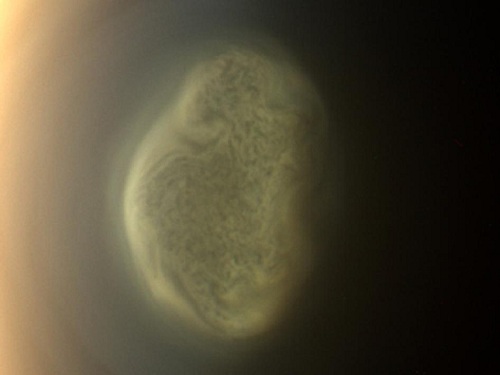
Image: This true color image captured by NASA’S Cassini spacecraft before a distant flyby of Saturn’s moon Titan on June 27, 2012, shows a south polar vortex, or a mass of swirling gas around the pole in the atmosphere of the moon. The south pole of Titan (3,200 miles, or 5,150 kilometers, across) is near the center of the view. NASA/JPL-Caltech/Space Science Institute.
In Cassini’s first years at Saturn, Titan’s north pole was associated with a high-altitude hot spot at a time of northern winter. A visible ‘hood’ of dense high altitude haze remained lit by sunlight even though much of the northern latitudes remained dark. As the southern hemisphere moved into autumn and began to tilt away from the Sun, the north pole hot spot began to disappear, while similar features — evidently induced by the compression of sinking air above the pole — started showing up at the south pole. The reversal from uplift to sinking air evidently occurred in a period of six months around the equinox of August 2009, when the Sun was directly over Titan’s equator. Within two years of the reversal, some of the gases CIRS tracks had increased 100-fold.
“Next, we would expect to see the vortex over the south pole build up,” said Mike Flasar, the CIRS principal investigator at NASA’s Goddard Space Flight Center in Greenbelt, Md. “As that happens, one question is whether the south winter pole will be the identical twin of the north winter pole, or will it have a distinct personality? The most important thing is to be able to keep watching as these changes happen.”
The story involves more than changes in Titan’s vertical winds. The CIRS instrument also found that complex chemicals are being produced at altitudes up to 600 kilometers above the surface, showing us that atmospheric circulation extends a good deal higher than expected. In fact, complex chemistry and vertical movement in the atmosphere occur above the haze layer first detected by the Voyager spacecraft. What had been thought to be a ‘detached’ layer of haze may actually be a transformational area where small haze particles combine before descending deeper into the atmosphere, where they produce the orange color characteristic of the moon.
The paper is Teanby et al., “Active upper-atmosphere chemistry and dynamics from polar circulation reversal on Titan,” Nature Vol. 491 No. 7426 — I’ll have a link to the abstract when Nature‘s servers, currently down, get back online. More in this JPL news release.

On Debris Disks and Super-Earths
The red dwarf Gliese 581 continues to draw the eye, whether or not the putative world Gl 581 g is there or not. The latter, whose existence has been the subject of controversy, would occupy a tantalizing place in its star’s habitable zone, though in some models the planet Gl 581 d might also skirt the outer edge of the HZ. Now we have interesting new work from the European Space Agency’s Herschel space observatory announcing that Gl 581, along with the G-class star 61 Vir, another nearby planetary system, shows the the signature of cold dust at -200 degrees Celsius.
It’s an abundant signature, too, meaning that both these systems must have ten times the number of comets found in our own Solar System’s Kuiper Belt. The two papers on this work grow out of a program called, fittingly, DEBRIS (Disc Emission via a Bias-free Reconnaissance in the Infrared/Sub-mm). What the researchers working these data are suggesting is that the lack of a large gas giant in the two systems may relate to the dense debris cloud. Instead of an era of heavy bombardment triggered by gas giants disrupting the Kuiper Belt, as occurred in our system, these stars may have experienced a much gentler inflow of volatiles. Thus Mark Wyatt (University of Cambridge), lead author of the paper on 61 Vir:
“The new observations are giving us a clue: they’re saying that in the Solar System we have giant planets and a relatively sparse Kuiper Belt, but systems with only low-mass planets often have much denser Kuiper belts… We think that may be because the absence of a Jupiter in the low-mass planet systems allows them to avoid a dramatic heavy bombardment event, and instead experience a gradual rain of comets over billions of years.”
Have a look at this Herschel image showing the situation around Gl 581:
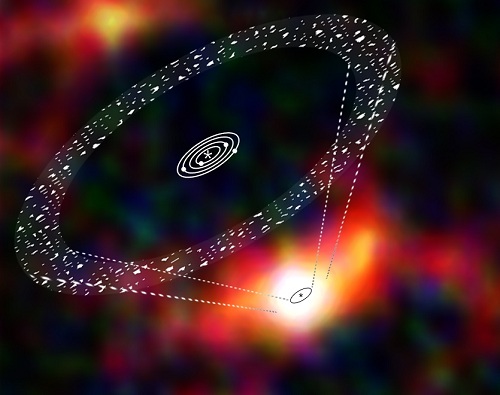
Image: An expanded diagram of the debris disc and planets around the star known as Gliese 581, superimposed on a composite Herschel image assembled from separate observations made with its PhotoArray Camera and Spectrometer (PACS) at 70, 100 and 160 micrometre wavelengths. The white region in the lower centre of the image is the emission that originates almost entirely from the disc, with only a small contribution from the unseen Gliese 581. The line drawing superimposed on the Herschel image gives a schematic representation of the location and orientation of the star, planets and disc, albeit not to scale. The black oval outline sketched onto the Herschel data represents the innermost boundary of the debris disc; the approximate location of the outermost boundary is represented by the outer set of dashed lines. Credit: ESA/AOES.
An older star like Gl 581 would have had two billion years or so for a substantial amount of water to be delivered to the inner system and, of course, to any potentially habitable worlds that reside there. What we now believe about the planets circling Gl 581 is that they have masses between 2 and 15 times that of the Earth, all located within 0.22 AU of the star, while the debris disk extends from 25 AU to 60 AU. A Neptune-class world further out, however, is a possibility. The researchers believe the large amount of dust Herschel has detected must be the result of cometary collisions, which could be triggered by a planet — perhaps about as large as the close-in planets — orbiting near the debris disk.
So we are looking at larger debris disks around systems where there is no Jupiter-class planet, and far less dense disks around stars where large gas giants are found. The paper on Gl 581 adds:
It is intriguing that, in our current analysis of the DEBRIS sample of 89 M-stars, the only debris disk con?dently detected around a mature M-star also happens to be around the only star known to have low mass planets. This could mean that the correlation between low-mass planets and debris disks recently found for G-stars by Wyatt et al. (2012) also applies to M-stars. Then, the high fraction (? 25%) of M-stars known to host low mass planets in the radial velocity and Kepler observations should make debris disks relatively common around them. If these disks have not been detected yet, it may be because searches have simply not been deep enough, or because the disk around GJ 581 is the brightest owing to some intrinsic properties ; for example hosting a multiple planetary system.
Modeling of the debris disk around the G-class star 61 Vir shows that the dust extends from 30 AU to at least 100 AU. The two planets known to orbit the star have masses between 5 and 18 times that of the Earth, and are located within 0.22 AU. The paper on 61 Vir summarizes the situation with regard to G-class stars:
There is likely little interaction between the disk and the known planets, which are at < 0.5AU. The lack of planetesimals in the < 30AU region could be explained by the existence of planets in this region, but the depletion can also be explained by collisional erosion... Considering a sample of the nearest 60 G stars there is an emerging trend that stars which, like 61 Vir, only have low-mass planets, are more likely to have detectable debris... We attribute this trend to the fact that the formation processes that make low-mass planets are likely to also result in large quantities of distant debris.
The papers are Wyatt et al., “Herschel imaging of 61 Vir: implications for the prevalence of debris in low-mass planetary systems,” in press at Monthly Notices of the Royal Astronomical Society (preprint), and Lestrade et al., “A DEBRIS Disk Around The Planet Hosting M-star GJ581 Spatially Resolved with Herschel,” accepted by Astronomy and Astrophysics (preprint).

Life Around Cooling Stars
Red dwarfs offer fascinating astrobiological speculation, allowing us to ponder whether flare activity or tidal lock could be the game-changer that prevents life from developing around them. We have much to learn on that score, but new work from Rory Barnes (University of Washington) and René Heller (Leibniz Institute for Astrophysics, Potsdam) looks beyond red dwarfs to brown and white dwarfs and their own prospects for life. The prognosis: Poor. Planets around these objects, the researchers say, would have an early history that could remove surface water.
The problem is nuclear burning and the lack thereof. Yes, both brown and white dwarfs could support a habitable zone, but what sets them apart from red dwarfs is that they cool slowly and continuously, meaning their habitable zones shrink inward toward the star. Imagine, Barnes and Heller say, a planet that starts out as a Venus-like world beset with a runaway greenhouse effect. Eventually the habitable zone contracts enough to create the needed temperatures for liquid water to exist, but by now the planet’s surface water is gone and so is the chance for life.
“These planets, if we find them today in a current habitable zone, previously had to have gone through a phase which sterilized them forever,” Barnes said. Heller added, “So, even if they are located in the habitable zone today, they are dead.”
The paper speaks in terms of the ‘insolation habitable zone,’ that region for which radiation flux from the star equals what we find in the habitable zone around main-sequence stars. But simply being in that zone is not sufficient. Here’s the case in a nutshell, as described in the paper:
The identi?cation of this so-called insolation habitable zone (IHZ) is an important ?rst step in constraining the possibility of habitable planets orbiting WDs and BDs, but one cannot neglect how a planet behaves prior to the arrival of the IHZ at its orbit. The inner edge of the HZ is de?ned to be the orbits at which a desiccating greenhouse, either moist, runaway or tidal, is just possible (Kasting et al. 1993; Barnes et al. 2012). These phenomena may ultimately remove all surface water and leave an uninhabitable planet behind. Thus, planets initially interior to the HZ may not actually be habitable after the primary has cooled and/or tidal heating has subsided su?ciently for the planet to reside in it. Note that we will refer to the HZ as resulting from both irradiation and tidal heating, but to the IHZ as the classic habitability model of e.g. Kasting et al. (1993).
The reference to tidal heating is inserted because the close proximity of the IHZ to the star raises concern that tidal heating effects could be in themselves strong enough to trigger the runaway greenhouse scenario, even for planets with extremely low eccentricities. But what of planets that enter the IHZ from a more distant orbit, jarred by gravitational instabilities in the system? Large eccentricities could still dish up enough tidal heating to sterilize the surface, but Barnes and Heller add that we would not be able to recognize such a history for a planet whose orbit had gradually been circularized, so there is still some possibility of life in such places.
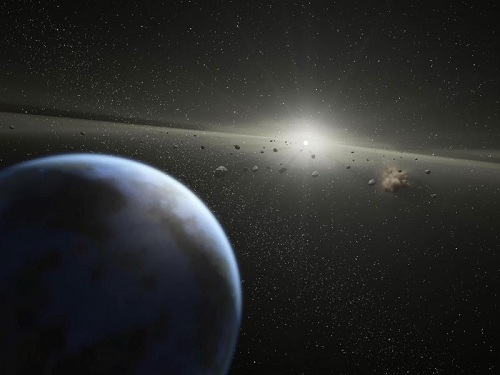
Image: An artist’s impression of a massive asteroid belt in orbit around a star. Recent work with SDSS data shows that similar rubble around many white dwarfs contaminates these stars with rocky material and water. Could planets support life in the habitable zone around such stars? Credit: NASA-JPL / Caltech / T. Pyle (SSC).
Is this category of star likely to have planets in the first place? The researchers note that no terrestrial planets have yet been found around either white or brown dwarfs, but they may well exist. We do have observations suggesting gas giants around both classes of star — the paper on this work goes into the details — and there is evidence of protoplanetary disks around brown dwarfs that could form into terrestrial worlds, while some white dwarfs are known to have metal-rich disks. And we have the interesting example of KOI 55, which has two terrestrial planet candidates orbiting a ‘horizontal branch’ star that seems well on its way to white dwarf status.
More work is needed to determine whether planets can become habitable after long periods in a runaway greenhouse phase, and whether migration scenarios exist for white and brown dwarf planets that could result in habitable outcomes. The authors, noting the complexity of the analysis, add that they cannot rule out habitability but call the journey to it ‘a difficult path.’ The paper is Barnes and Heller, “Habitable Planets Around White and Brown Dwarfs: The Perils of a Cooling Primary.” I don’t see the preprint up on the arXiv site as yet but will post the link (and the full citation in Astrobiology) as soon as I have them. More in this University of Washington news release.

Makemake and the Naming of Names
Now that we have vast numbers of Kuiper Belt Objects assumed to be orbiting outside the orbit of Neptune, not to mention possible Oort Cloud interlopers (Sedna may be one of these), the question of names gets ever more interesting. Great entertainment awaits, as witness the KBO known as 2005 FY9. Discovered not long after Easter in 2005, it quickly gained the nickname Easterbunny. It’s now, after several years, been re-christened Makemake, but I like what Mike Brown, who led the discovery team, has to say about this dwarf planet and its earlier monicker:
Three years is a long time to have only a license plate number instead of a name, so for most of the time, we simply referred to this object as “Easterbunny” in honor of the fact that it was discovered just a few days past Easter in 2005. Three years is such a long time that I think I’m going to have a hard time calling Makemake by its real name. For three years we’ve been tracking it in the sky, observing it with telescopes on the ground and in space, writing proposals to observe it more, writing papers based on what we see, and, all the while, we have just called it – at least amongst ourselves – Easterbunny. If you came in tomorrow and told me that from now on my daughter – who also just turned three – was to suddenly be called something new, I would have a hard time with that, too.
Most parents would, I imagine. Meanwhile, Makemake is itself an interesting name which for some time now has had sanction from the International Astronomical Union. Rapa Nui, also known as Easter Island, is home to the mythology from which the god Makemake — the creator of humanity and the god of fertility — springs. Brown says the name is pronounced ‘maki-maki,’ and in the absence of any background in Polynesian languages, I’ll take his word for it. Interestingly, Brown goes on to say that coming up with a permanent name for Easterbunny was his biggest naming challenge. This really does get entertaining:
Easterbuuny? It’s orbit is not particularly strange, but it is big. Probably about 2/3 the size of Pluto. And it is bright. It is the brightest object in the Kuiper belt other than Pluto itself. Unlike, say 2003 EL61, which has so many interesting characteristics that it was hard choosing from so many different appropriate name (more on this later), Easterbunny has no obvious hook. Its surface is covered with large amounts of almost pure methane ice, which is scientifically fascinating, but really not easily relatable to terrestrial mythology. (For a while I was working on coming up with a name related to the oracles at Delphi: some people interpret the reported trance-like state of the oracles to be related to natural gas [methane] seeping out of the earth there. After some thought I decided this theme was just dumb.)
Although it’s tempting, I won’t quote the whole piece, but send you to Brown’s lively What’s In a Name? for more. Clearly, the Easter connection linking the object’s discovery with Easter Island was the deciding issue, and it’s one that lets Makemake join other KBOs in having a name that fits its station. Eris, for example, was the Greek goddess of discord, a fitting name for the object causing a planetary re-juggling that resulted in Pluto’s demotion to ‘dwarf planet.’ Orcus was an Etruscan counterpart to Pluto, and with its large moon, Orcus does resemble Pluto in many ways (some call it the ‘anti-Pluto’). Sedna was an Inuit goddess of the sea, a cold name for this incredibly distant world with the highly elliptical orbit.
Makemake Under Observation
As to its own composition, Makemake is about ? the size of Pluto, with many astronomers expecting to find an atmosphere there. But observations with European Southern Observatory instruments in Chile have used a stellar occultation to determine that Makemake has no atmosphere of any significance. The occultation was highly useful — Makemake is a difficult object because of its lack of moons and the distance involved, and the new work not only offers up information about the lack of atmosphere but also helps us determine its size more accurately, as well as allowing estimates of its density. We also get an albedo measurement showing a reflectivity higher than Pluto’s but somewhat less than that of dwarf planet Eris.
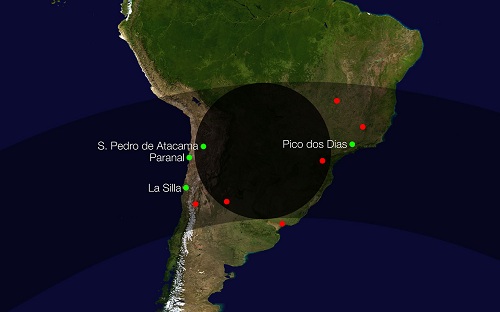
Image: This diagram shows the path of the shadow of the dwarf planet Makemake during an occultation of a faint star in April 2011. Several sites in South America, including ESO’s La Silla and Paranal Observatories, saw the star disappear briefly as its light was blocked by Makemake. This dwarf planet is about two thirds of the size of Pluto, and travels around the Sun in a distant path that lies beyond that of Pluto, but closer to the Sun than Eris, the most massive known dwarf planet in the Solar System. Makemake was expected to have an atmosphere like Pluto, but the new occultation data show that this is not the case. Credit: ESO/L. Calçada.
José Luis Ortiz (Instituto de Astrofísica de Andalucía, CSIC, Spain), who led this work, comments on its significance:
“As Makemake passed in front of the star and blocked it out, the star disappeared and reappeared very abruptly, rather than fading and brightening gradually. This means that the little dwarf planet has no significant atmosphere. It was thought that Makemake had a good chance of having developed an atmosphere — that it has no sign of one at all shows just how much we have yet to learn about these mysterious bodies. Finding out about Makemake’s properties for the first time is a big step forward in our study of the select club of icy dwarf planets.”
These observations, combined with earlier work, indicate that Makemake’s density is 1.7 ± 0.3 grams per cubic centimeter. From this, the team infers that the object is in the shape of a sphere somewhat flattened at the poles, with axes of 1430 ± 9 kilometres and 1502 ± 45 kilometres. This ESO news release offers more details.
The star occulted by Makemake was NOMAD 1181-0235723, with an event lasting no longer than a minute. In all, seven different telescopes across Brazil and Chile were used in the observations. The paper on this work is Ortiz et al., “Albedo and atmospheric constraints of dwarf planet Makemake from a stellar occultation,” Nature 491 (22 November 2012), pp. 566-569 (abstract).

Interstellar Propulsion Exotica
It was back in 1950 that Arthur C. Clarke looked at electromagnetic methods for getting a payload into space. The concept wasn’t new but Clarke’s paper in JBIS set out to examine what he saw as a practical use of it, an electromagnetic catapult on the lunar surface that could accelerate payloads back to Earth. The system was built around a three-kilometer long electromagnetic launcher that could accelerate payloads at 100 g’s to 2.3 kilometers per second (lunar escape velocity) in a matter of seconds. Gerard O’Neill thought such methods could deliver lunar raw materials to low Earth orbit for delivery to a space manufacturing site.

Clarke’s ideas played naturally into O’Neill’s, for building large space habitats requires vast amounts of raw materials that we’d just as soon not have to lift out of Earth’s gravity well. But Clarke’s thinking wasn’t restricted to near-Earth uses of the technology. He saw no necessary limit to the lengths and accelerations that could be used. Provide enough power to a space-based electromagnetic launcher and it could be configured to send robotic payloads to nearby stars. As with solar sails, we’re accelerating no propellant — only the payload — and that’s magic to any rocket scientist.
By the time E. H. Lemke looked at the idea in 1982, the size of such launchers had become astronomical. Lemke’s accelerator reached 108 kilometers in length, and used a solar collecting array hundreds of kilometers to the side to store the energy needed to boost payloads up to a third of lightspeed. Probes would be flung at 5000 g’s to nearby stars. It’s hard to see how a civilization capable of building on a scale like this (Lemke’s accelerator would be ? of an astronomical unit long!) wouldn’t also have developed smaller and more efficient ways of sending probes on the same journey, but the same could be said for many giant sail concepts.
Clifford Singer’s work at Princeton on ‘pellet stream propulsion’ makes use of both Clarke and Lemke to arrive at a somewhat more adaptable idea. Writing in 1980, Singer proposed using a stream of electromagnetically charged pellets to transfer momentum to a departing interstellar craft. You can think in terms of a lightsail being pushed by a laser or microwave beam, but in this case the beam is composed of macroscopic pellets, each with a mass of several grams, being dispatched at 0.2 c to the starship, where they would impact and impart momentum.
At 105 kilometers in length, Singer’s electromagnetic launcher would be huge, though not on the scale of Lemke’s. In the original work, Singer emphasized that a system like this solved the collimation problem — the spread of the beam over distance — that would be faced by laser-beamed missions. His idea was to use several dozen stations, perhaps deployed by the starship itself, to measure pellet positions and send the needed commands to adjust their course at the launcher. He examined the question of dispersion due to the impact of interstellar dust grains along the route and concluded that pellets of 1 gram and up could be delivered to the starship with accuracy.
Later, Gerald Nordley would take the logical leap of ‘smart’ pellets, with enough technology aboard to adjust their course as required. Nordley’s ‘snowflake’ pellets would be built around nanotechnology and could find their own way to a starship that could itself make small changes in course if required to stay within the stream. And Jordin Kare subsequently produced ‘SailBeam,’ in which Singer’s pellets give way to tiny ‘micro-sails’ that can be accelerated to the departing starship and vaporized upon approach, becoming a plasma that drives the spacecraft.

Image: Jordin Kare’s ‘SailBeam’ concept. Credit: Jordin Kare/Dana G. Andrews.
SailBeam, which was a hybrid system crossing pellet propulsion with lightsails, also offered a major advantage. Kare’s studies demonstrated that you could accelerate a large number of small sails with a far less demanding optical system than required by a huge lightsail. The sails could also be accelerated much closer to their power source, which simplifies the problems of maintenance and sail deployment faced by a large sail under the beam for lengthy periods. Made of diamond film, Kare’s sails would accelerate to close to lightspeed within seconds.
So many concepts, so little time! Digging into interstellar exotica is a refreshing exercise that reminds me how many concepts have been kicked around in the literature. Most are grossly impractical given our level of technology, but the refining of some of them seen in Nordley and Kare’s work shows that we can at least nudge some of these notions in a more practical direction. Practical, that is, for a future with greater energy resources and wider options within the Solar System than we enjoy.
The original Arthur C. Clarke paper is “Electromagnetic Launching as a Major Contribution to Space-Flight,” JBIS 9 (6) (1950), pp. 261-267. It’s reprinted in Clarke’s Ascent to Orbit: A Scientific Autobiography (New York: John Wiley & Sons, 1984). The Lemke paper is “Magnetic Acceleration of Interstellar Probes,” JBIS 35 (1982), pp. 498-503. Cliff Singer’s first pellet paper is “Interstellar Propulsion Using a Pellet Stream for Momentum Transfer,” JBIS 33 (1980), pp. 107–115. And you can find Jordin Kare’s NIAC report “High-Acceleration Micro-Scale Laser Sails for Interstellar Propulsion,” (Final Report, NIAC Research Grant #07600-070, revised February 15, 2002) on the NIAC site.

